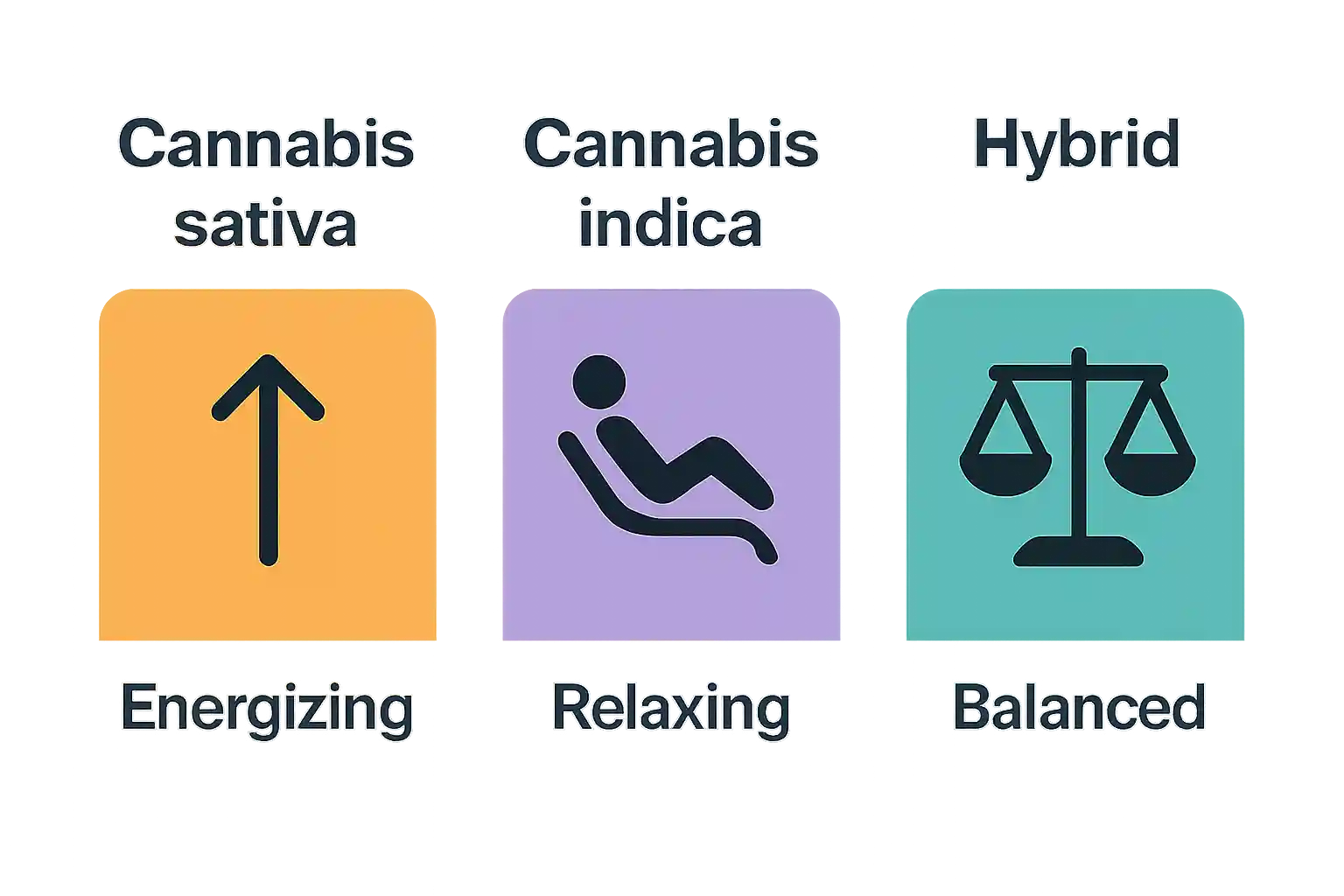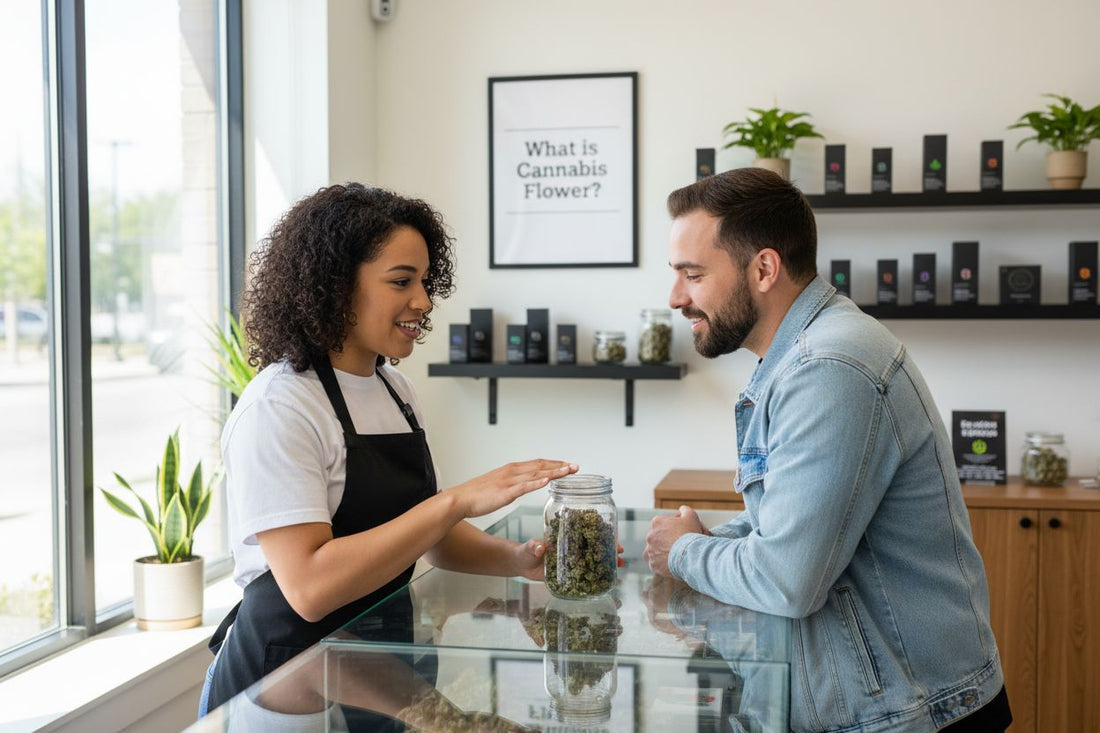Cannabis flower is often seen as the core of any cannabis experience, holding the raw and natural form of the plant itself. Many people are surprised to learn that cannabis plants are fundamentally categorized into three main types: sativa, indica, and hybrid. But the real story goes deeper than labels—what actually makes these buds unique is the powerful combination of cannabinoids and terpenes hiding in their sticky trichomes, driving everything from flavor to effects.
Table of Contents
- The Basics: What Is Cannabis Flower?
- Why Cannabis Flower Matters: Importance In Consumption
- How Cannabis Flower Works: The Science Behind It
- Key Concepts: Types, Strains, And Characteristics
Quick Summary
| Takeaway | Explanation |
|---|---|
| Cannabis flower contains cannabinoids and terpenes | These compounds define the unique properties of each strain, impacting its effects and therapeutic potential. |
| Cannabis flower offers versatile consumption methods | Users can smoke, vaporize, brew, or incorporate it into foods, catering to personal preferences and medical needs. |
| Cannabis types impact effects and characteristics | Understanding different types (sativa, indica, hybrids) helps users select strains that align with their desired outcomes. |
| The entourage effect enhances therapeutic benefits | The synergy between cannabinoids and terpenes in whole flower may provide superior relief compared to isolated extracts. |
| Individual experiences with cannabis vary widely | Personal physiology, strain characteristics, and cannabinoid ratios influence how cannabis flower affects users differently. |
The Basics: What is Cannabis Flower?
Cannabis flower represents the raw, unprocessed reproductive part of the female cannabis plant, serving as the primary source of cannabinoids like THC and CBD. According to National Institute on Drug Abuse, these dried and cured buds are the most natural and traditional form of cannabis consumption.
Botanical Origins and Structure
The cannabis flower emerges from the female cannabis plant, characterized by dense, sticky buds covered in tiny crystal-like structures called trichomes. These trichomes are crucial because they contain the highest concentration of cannabinoids and terpenes that define the plant’s unique properties. Botanically, these flowers are reproductive structures designed to produce seeds, though in cultivated cannabis, they are typically harvested before seed production to maximize cannabinoid content.
Characteristics and Components
Cannabis flowers are distinguished by several key characteristics. They typically range in color from deep green to purple, depending on the strain and growing conditions. The surface is covered with resinous glands called trichomes, which appear like tiny crystalline hairs. These trichomes are responsible for producing:
- Cannabinoids like THC and CBD
- Terpenes that contribute to flavor and aroma
- Essential oils that influence the plant’s effects
Understanding these fundamental components helps consumers and medical users read more about cannabis product variations and make informed choices about consumption methods and potential therapeutic applications.
The complexity and diversity of cannabis flowers make them a fascinating subject of botanical and medical research, offering a natural approach to exploring potential wellness and recreational experiences.
For quick reference, this table summarizes key features found in cannabis flower and their significance for users.
| Feature | Description | Importance |
|---|---|---|
| Trichomes | Crystal-like, resinous glands on flower surface | Contain most cannabinoids and terpenes |
| Cannabinoids | Chemical compounds (e.g., THC, CBD) | Influence psychoactive and therapeutic effects |
| Terpenes | Aromatic plant oils | Affect flavor, aroma, and potential effects |
| Color Variation | Deep green to purple hues | Indicates strain, growing conditions |
| Seed Content | Presence or absence of seeds | Seedless (sinsemilla) maximizes cannabinoid content |
| Essential Oils | Natural oils from the plant | Contribute to overall effects and experience |
Why Cannabis Flower Matters: Importance in Consumption
Cannabis flower holds significant importance in both recreational and medicinal contexts, offering a direct and unprocessed method of cannabis consumption. According to National Institute on Drug Abuse, the flower represents the most authentic form of cannabis interaction, delivering a complex profile of compounds that interact with the human body.
Therapeutic and Recreational Potential
Cannabis flower provides a full-spectrum experience that distinguishes it from processed cannabis products. The comprehensive blend of cannabinoids and terpenes creates what researchers call the “entourage effect,” where multiple compounds work synergistically to enhance potential therapeutic benefits. This means the flower can offer more nuanced and potentially more effective outcomes compared to isolated cannabinoid extracts.
Consumption Methods and Versatility
The versatility of cannabis flower allows multiple consumption methods, making it adaptable to individual preferences and medical needs. Users can choose from various approaches:

- Smoking traditional joints or pipes
- Vaporizing for a cleaner inhalation experience
- Brewing into teas
- Grinding for use in culinary preparations
Explore our guide on cannabis product preparation to understand the diverse ways cannabis flower can be integrated into different consumption techniques.
Beyond recreational use, cannabis flower plays a crucial role in medical applications, offering potential relief for conditions like chronic pain, anxiety, and sleep disorders. Its natural, minimally processed state provides patients with a direct connection to the plant’s intrinsic therapeutic properties, making it a fundamental component of cannabis wellness strategies.
How Cannabis Flower Works: The Science Behind It
Cannabis flower operates through a complex interaction with the human body’s endocannabinoid system, delivering unique physiological and psychological effects.
According to National Center for Biotechnology Information, the intricate biochemical mechanisms of cannabis involve multiple molecular pathways that influence neurological and physiological processes.
Endocannabinoid System Interaction
The human body contains a sophisticated molecular communication network known as the endocannabinoid system, which comprises receptors strategically located throughout the brain and body. When cannabis flower is consumed, its primary compounds cannabinoids like THC and CBD interact with two primary receptor types: CB1 (predominantly in the brain) and CB2 (found in the immune system). This interaction triggers a cascade of biochemical responses that can modulate pain perception, mood, appetite, and immune function.
Molecular Mechanisms of Cannabinoids
Cannabinoids in the flower engage with the body through several key mechanisms:
- Binding to cannabinoid receptors and altering neurotransmitter release
- Modulating neural signaling pathways
- Influencing inflammatory responses
- Regulating cellular communication
Learn more about the role of THC in cannabis experiences to gain deeper insights into how these molecular interactions translate into observable effects.
The complexity of cannabis flower’s biochemical interactions underscores why individual experiences can vary significantly. Factors such as specific cannabinoid ratios, terpene profiles, and an individual’s unique physiological makeup all contribute to the nuanced ways cannabis flower interacts with human biology, making each consumption experience potentially unique and multifaceted.
Key Concepts: Types, Strains, and Characteristics
Cannabis flower represents a complex botanical landscape with diverse types, strains, and unique characteristics that significantly impact user experience. According to National Center for Biotechnology Information, cannabis varieties exhibit remarkable genetic diversity that influences their chemical composition and potential effects.
Primary Cannabis Types
Cannabis plants are fundamentally categorized into three primary types: Cannabis sativa, Cannabis indica, and hybrid strains. Each type possesses distinctive traits that differentiate their growth patterns, cannabinoid profiles, and potential physiological impacts.
 Sativa strains typically feature higher energy and cerebral effects, while indica varieties are associated with relaxation and physical sedation. Hybrid strains combine characteristics from both parent types, offering more nuanced and balanced experiences.
Sativa strains typically feature higher energy and cerebral effects, while indica varieties are associated with relaxation and physical sedation. Hybrid strains combine characteristics from both parent types, offering more nuanced and balanced experiences.
Strain Characteristics and Profiles
Cannabis strains are distinguished by several critical components that determine their unique properties:
- Cannabinoid ratios (THC to CBD percentages)
- Terpene composition and concentration
- Genetic lineage and breeding history
- Geographical origin and cultivation conditions
Explore our comprehensive guide on cannabis product variations to understand how these characteristics translate into different consumption experiences.
The intricate interplay between genetic heritage, growing environment, and chemical composition makes each cannabis strain a unique botanical expression. Consumers and medical users can select strains based on specific desired outcomes, whether seeking pain relief, creativity enhancement, relaxation, or symptom management.
To help you compare how the main types of cannabis flower differ, here is a table outlining their growth patterns, chemical composition, and typical effects.
| Type | Growth Pattern | Common Cannabinoid Profile | Typical Effects |
|---|---|---|---|
| Sativa | Tall, slender, narrow leaves | Often higher in THC | Uplifting, energetic, cerebral |
| Indica | Short, bushy, broad leaves | Often higher in CBD (some THC) | Relaxing, sedating, body-focused |
| Hybrid | Combination of both | Varies by parent strains | Balanced or blended effects |
Ready to Experience the Power of Cannabis Flower?
After learning how cannabis flower connects to the body’s endocannabinoid system and how important strain selection is for a personalized experience, you might feel overwhelmed by choices or concerned about quality and transparency. Many people worry about picking the right product that delivers the entourage effect or meets specific wellness needs, especially with so many options on the market.

Discover Avondale Apothecary, where you can explore a curated selection of premium cannabis flowers and related products. Our site provides detailed product listings and Certificates of Analysis with every item so you can shop with confidence. If you are ready to find the best strains or want to learn how whole flower compares to other options, visit our user-friendly homepage and start your journey to a more informed, satisfying cannabis experience. Make your next choice with clarity and assurance—explore our collection today while supplies last.
Frequently Asked Questions
What is cannabis flower?
Cannabis flower is the raw, unprocessed reproductive part of the female cannabis plant, primarily used for its cannabinoids like THC and CBD.
What are the different types of cannabis flowers?
There are three primary types of cannabis plants: Cannabis sativa, Cannabis indica, and hybrids. Each type has unique characteristics that influence their effects and growth patterns.
How does cannabis flower interact with the body?
Cannabis flower interacts with the body’s endocannabinoid system, where cannabinoids like THC and CBD bind to receptors, influencing pain perception, mood, appetite, and more.
What are the methods of consuming cannabis flower?
Cannabis flower can be consumed through various methods, including smoking, vaporizing, brewing into teas, or using it in culinary preparations.

